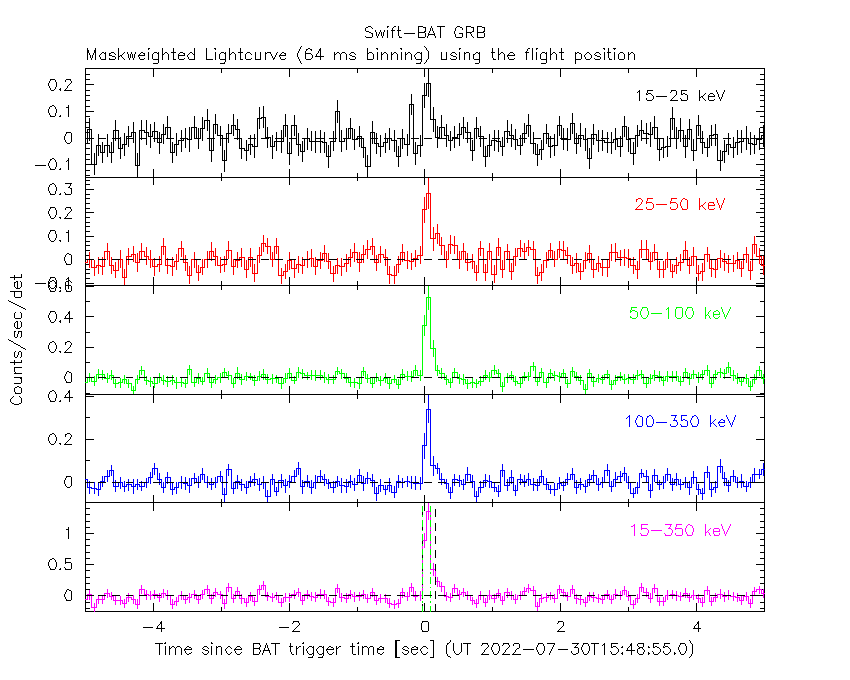
S. Dichiara (PSU), A. D'Ai (INAF-IASFPA) and N.P.M. Kuin (UCL-MSSL) for the Swift team
At 15:48:55 UT, the Swift Burst Alert Telescope (BAT) triggered and located GRB 220730A (trigger=1118357) (Dichiara et al. GCN Circ. 32431). Swift slewed immediately to the burst. At the time of the trigger, the initial BAT position was 109° from the Sun (6.4 hours East) and 100° from the 3%-illuminated Moon. Table 1 contains the best reported positions from Swift.
Table 2 is a summary of GCN Circulars about this GRB from observatories other than Swift.
Standard analysis products for this burst are available at https://gcn.gsfc.nasa.gov/swift_gnd_ana.html.
The partial coding was 60%.
The mask-weighted light curve (Figure 1) shows a single FRED-shaped pulse from
approximately T-0.05 to T+0.25 seconds.
The results of the batgrbproduct analysis are available at https://gcn.gsfc.nasa.gov/notices_s/1118357/BA/.
Analysis of the initial XRT data was reported by Dichiara et al. (GCN Circ. 32436). Of the sources reported by D'Ai et al. (GCN Circ. 32434), "Source 5" is fading with >3-sigma significance and is believed to be the afterglow.
The Swift/UVOT began settled observations of the field of GRB 220730A 112 s after the BAT trigger
(Kuin and Dichiara GCN Circ. 32435).
No optical afterglow consistent with any of the positions in GCN Circ. 32434 (D'Ai et al.) has been detected in the initial UVOT exposures.
Table 3 gives preliminary
magnitudes using the UVOT photometric system
(Breeveld et al. 2011, AIP Conf. Proc., 1358, 373).
No correction has been made for the expected extinction in the Milky Way
corresponding to a reddening of

Figure 1. The BAT
mask-weighted light curve in the four individual and total
energy bands. The units are counts
| RA (J2000) | Dec (J2000) | Error | Note | Reference |
|---|---|---|---|---|
| 1 |
-69°29'45.4" | 6.6" | XRT | Dichiara et al. GCN Circ. 32436 |
| 1 |
-69°29'44.5" | 1.7' | BAT-refined | Markwardt et al. GCN Circ. 32438 |
| Band | Authors | GCN Circ. | Subject | Observatory | Notes |
|---|---|---|---|---|---|
| Optical | Lipunov et al. | 32432 | Swift GRB 220730A: Global MASTER-Net observations report |
MASTER | |
| Gamma-ray | Poolakkil and Meegan | 32437 | Fermi GBM detection | Fermi GBM | Fluence=1.06±0.09x1 (brighter than 83% of short GRBs) |
| Gamma-ray | Frederiks et al. | 32439 | Konus-Wind detection of GRB 220730A (short) |
Konus-Wind |
| Filter | Exp(s) | Mag | ||
|---|---|---|---|---|
| whit |
112 | 261 | 147 | >20.5 |
| 324 | 574 | 246 | >19.8 | |
| white | 112 | 623 | 167 | >20.6 |
| v | 655 | 675 | 19 | >17.8 |
| b | 579 | 599 | 19 | >18.7 |
| u | 324 | 574 | 246 | >19.8 |
| w2 | 630 | 650 | 19 | >18.4 |
Table 3. UVOT observations reported by Kuin and Dichiara (GCN Circ. 32435). The start and stop times of the exposures are given in seconds since the BAT trigger. The preliminary 3-σ upper limits are given. No correction has been made for extinction in the Milky Way.
August 3, 2022